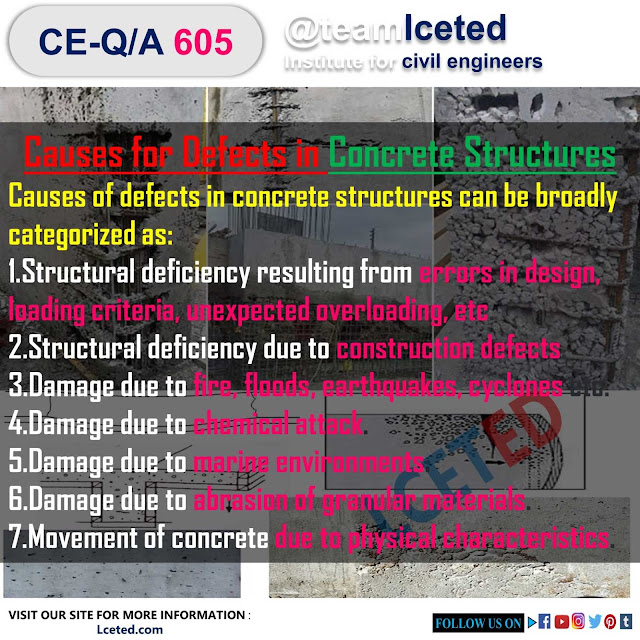Brief details of defects and damages
occurred in concrete are indicated below
along with their possible causes and suggested
investigations for ready reference:
CONCRETE
VISIBLE DEFECT | POSSIBLE CAUSES | INVESTIGATION SUGGESTED |
Rust on the surface. | Iron compounds in aggregates, nails/wires left in formwork. | Chemical analysis of samples. |
Rust stains on the surface. | Corrosion of binding wires, corrosion of reinforcement steel. | Check cover and carbonation of concrete. |
Cracking of concrete cover, exposure of reinforcement and spelling of concrete | Corrosion of reinforcement and other steel due to moisture and chloride ingress, frost attack and poor quality of concrete low density, high porosity and high water to cement ratio). | Check cover, test for chlorides and carbonation, check reinforcement adequacy. |
Surface crazing. | Concrete Mix too wet and poor curing. | Check concrete mix and construction method used. |
Random diagonal cracking, lateral cracking at equal spacing | Inadequate protection against shrinkage, over-rich or over wet and non-cohesive concrete. | Check reinforcement, spacing of joint, analyze samples of concrete. |
Repetitive vertical or horizontal cracks. | Joint spacing too large. | Examine joint details/spacing check concrete sample and aggregates used. |
Wet and damp spots, Deteriorated applied finishes without cracking. | Honeycombs due to poor placement of concrete mix, poor compaction or water stopper missing. | Check concrete after recovering applied finishes, checks detailing of joints, check for water stopper, test and analyze concrete. |
Cracks at intervals. | Restrained shrinkage, reinforcement too near the surface, corrosion of reinforcement, moisture movements. | Check to space of joints design), check the distribution of reinforcement, concrete sample. |
| Faulty movement joints, faulty or missing water stopper, inadequate or improperly constructed join, inadequate reinforcement. | Check concrete at joints, check water bars and reinforcement details. |
Rust stains below mortar covering of external pre-stressing. | Tendon corrosion, poor grouting of tendons. | Check location/ extent of corrosion. |
Map cracking. | Alkali-silica reaction (ASR), early drying out conditions, over-rich mixes, over compaction and poor curing. | Check concrete constituents, petrographic analysis. |
Surface abrasion. | Excessive wear. | Check abrasive loading, check the quality of the concrete surface, check the history of usage. |
Cracking or spelling with or without staining (generally parallel to the direction of reinforcement steel). | Corrosion of reinforcement steel or pre-stress tendons corrosion of encases steel, alkali-silica reaction (ASR), restrained by reinforcement. | Check the condition of embedded steel, check cover, carbonation, chloride content, check the presence of ASR. |
Deflection. | Shrinkable aggregate, premature removal of formwork, overloading. | Analysis of concrete samples design check. |
Local settlements along with diagonal cracks on footings (foundation) | Poor subgrade compaction, inadequate reinforcement, ground movement due to water/erosion/ mining/ shrinkage clays, peat or other causes. | Investigate foundation design and substrate. |
Vertical or slightly inclined cracks on sides and soffit on the central part of RCC beams. | If less than 0.3 mm: Normal if wider than 0.5 mm: Overload, excessive shrinkage of the slab, premature removal of props. | Check design, compare actual load with design load, check span/ depth ratio with code requirements, check temperature gradient |
Diagonally inclined cracks in beams, generally at or close to the supports. | Overloading, inadequate beams depth, inadequately provided reinforcement to prevent shear. | Check actual shear resistance against coal allowance. |
Vertical cracks in RCC beams at regular intervals. | Shrinkage around stirrups. | |
Helical cracks in RCC beams face and extending around the section perimeters. | Tensional shear stresses. | Check actual tensional resistance against coal requirement |
Excessive deflection of RCC beams. | Inadequate depth, overloading, formwork defect, inadequate or displace reinforcement, shrinkable aggregate, materials defective or deteriorated, bond failure between reinforcement and concrete. | Check span/depth ratio with code requirements, compare actual and theoretical deflections, check to load history, cover meter check, test concrete, check for defects in construction. |
Pre-stressed concrete beams with excessive deflection, excessive handing, loose or defective anchorage segment separation, grout disturbance and distribution not proper, segmental shear cracks. | Overloading, Overstressing Or poor concrete, inadequate pre-stresses, displaced tendons, material defective or deteriorated. | Check deflection, and stresses against actual load, check conditions of all tendons, check design, check cover by the cover meter. |
Bowing of pre-stressed columns. | Distortion during erection, concrete creep or shrinkage, tendon fractures, defective material or material deterioration. | Check loading conditions, check design and construction defects, check cover by cover meter, check tendon condition at any fracture. |
Excessive deflection in slabs and/or the heaving of tiles or cracking of tiles on the top surface. | Inadequate depth, overloading, for long period, defective formwork, inadequate or displaced steel reinforcement, material defective or deteriorated, lack of continuity. | Check span/depth ratio with code requirements, compare actual and theoretical deflections, check loading history, check cover by cover meter, check for shrinkable aggregates. |
If you find
This information helpful, please share it.
Thanks! For reading the article.









No comments:
Post a Comment